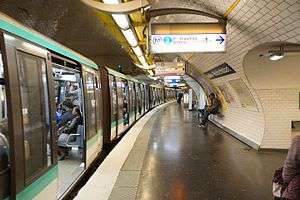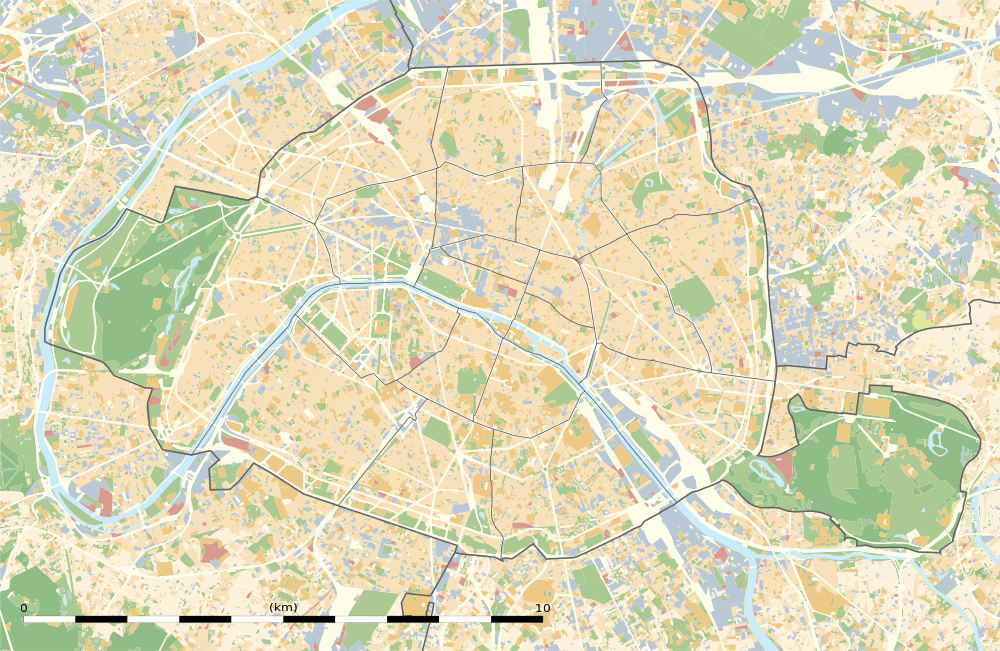Barbès – Rochechouart (Paris Métro)
Barbès – Rochechouart (French pronunciation: [baʁbɛs ʁɔʃəʃwaʁ]) is a station on Line 2 and Line 4 of the Paris Métro. Situated at the location where the 9th, 10th and 18th arrondissements all share a border point, the station is at the junction of Boulevard Barbès, named for the revolutionary, Armand Barbès, the Boulevard de Rochechouart, named for the abbess, Marguerite de Rochechouart, Boulevard de la Chapelle and Boulevard de Magenta.
| Paris Métro station | ||||||||||||||||
 Line 4 platforms | ||||||||||||||||
| Location | Boul. de la Chapelle × Boul. Magenta Boul. de la Chapelle × Boul. Barbès 1, Boul. Rochechouart 2, Boul. Rochechouart 45, Boul. de la Chapelle 9th, 10th and 18th arrondissement of Paris Île-de-France France | |||||||||||||||
| Coordinates | 48°53′01″N 2°21′02″E | |||||||||||||||
| Owned by | RATP | |||||||||||||||
| Operated by | RATP | |||||||||||||||
| Other information | ||||||||||||||||
| Fare zone | 1 | |||||||||||||||
| History | ||||||||||||||||
| Opened | 31 January 1903 (Line 2) 21 April 1908 (Line 4) | |||||||||||||||
| Previous names | Barbès (1903-1907) | |||||||||||||||
| Services | ||||||||||||||||
| ||||||||||||||||
| Location | ||||||||||||||||
 Barbès – Rochechouart Location within Paris | ||||||||||||||||
The station is the former location of the Barrière Poissonnière, a gate in the Wall of the Farmers-General built for the collection of excise taxes (the octroi). The gate was built between 1784 and 1788, and it was demolished in the nineteenth century.
History
The elevated Line 2 station was opened on 31 January 1903 as Boulevard Barbès station, as part of the extension of Line 2 from Anvers to Bagnolet'(now called Alexandre Dumas). It was renamed to its current name eight days later. Line 2 descends into a tunnel to the west of the station. The underground Line 4 station was opened on 21 April 1908 as part of the first section of the line from Châtelet to Porte de Clignancourt.
The disastrous fire of 10 August 1903 that resulted in eighty deaths at Couronnes station began at Barbès – Rochechouart. During World War II, on 21 August 1941, Pierre Georges and three companions of the French Resistance shot and killed a German naval cadet named Alfons Moser when he was boarding a train at the Barbès station at eight in the morning. The killing was in revenge for the execution of Samuel Tyszelman for taking part in an anti-German demonstration.[1] This was the start of a series of assassinations and reprisals that resulted in five hundred French hostages being executed in the next few months.[2]
Station layout
| Platform level | Side platform, doors will open on the right | |
| Westbound | ← | |
| Eastbound | | |
| Side platform, doors will open on the right | ||
| 1F | Mezzanine for Line 2 platform connection |
| Street Level |
| B1 | Mezzanine for Line 4 platform connection |
| Line 4 platforms | Side platform, doors will open on the right | |
| Northbound | ← | |
| Southbound | | |
| Side platform, doors will open on the right | ||
Gallery
 Entrance under Line 2 viaduct
Entrance under Line 2 viaduct
| Wikimedia Commons has media related to Barbès - Rochechouart (Paris Metro). |
References
- "Ce jeudi 21 août 1941, 8 heures". L'Humanité. 23 August 1994. Retrieved 6 June 2015.
- Hansen, Randall (2014). Disobeying Hitler: German Resistance After Valkyrie. Oxford University Press. p. 31. ISBN 978-0-19-992792-0. Retrieved 6 June 2015.
- Roland, Gérard (2003). Stations de métro. D’Abbesses à Wagram. Éditions Bonneton.